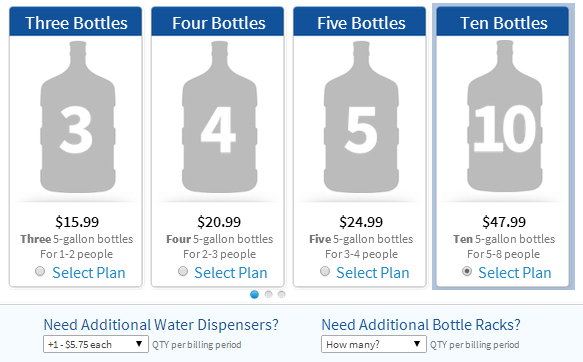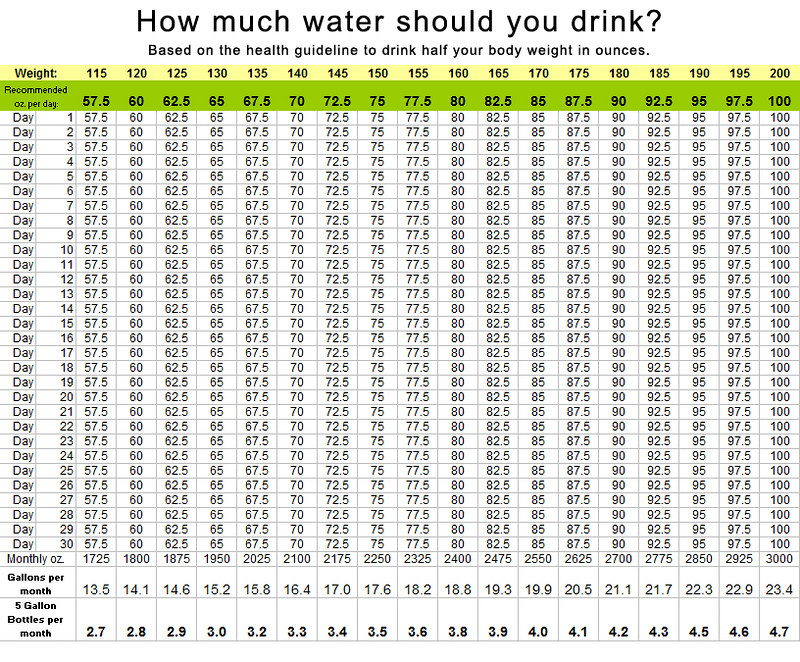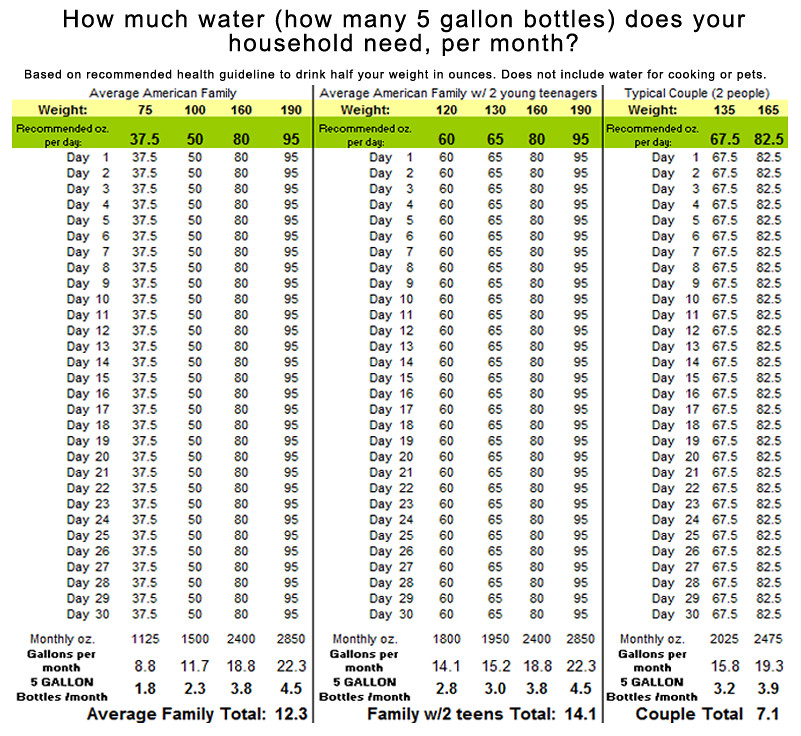However... what many Costco members may not realize, is that they can get premium filtered water, with even more convenience than home delivery, for much less than what Costco charges! In addition, there are many extra health benefits to drinking Kangen Water (which is recommended by Physicians, used in Japanese Hospitals) that you simply will not find in Reverse Osmosis water, which is what Costco/Alhambra uses, in the examples on this page. I know they also have a "Spring Water" service, but it is more expensive (and still won't have the antioxidant levels and as many reported health benefits as the Kangen Water).
I also really like arrowhead water and have consumed quite a bit of it in my lifetime. But I didn't know nearly as much about water, and the environmental costs of transporting it, as I do today.
There are many benefits to drinking water that you filter in your own home!
 Forego the heavy lifting, back strain and storage of your bottles.
Forego the heavy lifting, back strain and storage of your bottles.
When you have a Kangen machine at home, you won't have to carry heavy 5-gallon bottles from your door to your storage rack (or wherever else you keep them), and then load them onto your water dispenser. In addition, you won't have to worry about finding the space in your garage or kitchen, to store all those bottles, or leave them on your porch to be picked up. Some people find themselves drinking less than the amount of water they should, simply because they don't want to deal with lugging the heavy bottles onto their water coolers, or because they don't want to pay for extra bottles. But with a Kangen machine, you can drink unlimited amounts of Kangen water, and there is no heavy lifting!
Electrolytes, Antioxidants & High Cell Penetration... does your water offer that?
Whenever you want, you can make yourself a glass of fresh Kangen water that is high in antioxidants (10x more than green tea), penetrates cell walls 6 times more efficiently than regular water, and helps your body to transport nutrients and oxygen for greater hydration and endurance. Kangen water also helps you flush out lactic acid and uric acid after a workout, which means you are neutralizing free radicals and minimizing oxidative damage that ages your body.
There is a reason you find so many testimonials about Kangen water! Scroll down to see a much longer list of advantages.
Many people think it must be expensive to get a water ionizer, but they think nothing of buying bottled water or having it delivered at home for a monthly fee. Well, when you sit down and do a long term cost analysis, of a home delivery service, you will see that you can easily save money - a lot of it - by getting a Kangen / Enagic Machine - even when you use a high grade filter.
You can get your own machine starting as low as $44 per month, interest-free, for the first year, and you can make unlimited amounts of fresh Kangen water, which has electrolytes, micro-clustering, and 10x more antioxidants than green tea.

This is a screen shot of Arrowhead water's pricing. Please note this pricing may not necessarily reflect the total cost of their water delivery service. It also may not reflect any other types of recurring specials they may have (buy 12 months, get one free, etc). But specials aside, the regular price for the bottled water pictured below, after the first month, is approximately $1.30 per gallon for Nestle Pure Life, $1.50 for Arrowhead Natural spring Water, and $2.00 per gallon for Nestle Pure Life Natural Spring Water. This does not include the cost of any taxes, energy surcharges, or the cost of renting or buying a water cooler.

This is a screen shot of the pricing for Arrowhead's water coolers. Please note this does not include the cost of electricity. According to the Costco site, the Alhambra coolers seem to start at $5.75 per month.
Please note, the sample Costco bill below is for three 5-Gallon bottles (15 gallons total). This is a sample of a first bill, which will include the bottle deposit.


Making filtered, ionized water at home is also better for the environment than door-to-door delivery.
When you are paying for a home delivery service, you're paying a monthly fuel surcharge for a truck to carry heavy bottles to and from your door. In the Bay Area, the Alhambra water treatment facility is located in Milpitas, CA. A water delivery for a typical family of four (consuming the recommended amount of half their body weight in ounces of water, daily, whether it be for drinking or cooking) would require transporting 625 pounds of water per trip, which equates to 8,131 pounds of water per year, or 121,965 pounds of water over a 15-year period. Transporting this water to Redwood City is approximately a 44 mile drive, round trip, which equates to 572 miles driven per year, or 8,580 miles driven over a 15-year period.
I do realize the truck is carrying water for more than one person. On one hand it seems this should justify the cost of transportation via heavy trucks, and makes the process more efficient. And yet I still think... if the truck is delivering for 20 people, that is even more weight being transported, in order for people to have the convenience of home delivery.
It reminds me of how, I never thought about the environmental impact of using clumping cat litter until I read it an article about it. Like water, clumping cat litter is very heavy to transport - it's like cement. So transporting it to and from your home, and then putting it in your garbage can, for a truck to have to haul to the dump, has a pretty negative long-term impact in the environment. Whereas, using lighter, compostable cat litter will have less of a negative effect. Using a home filtration system for your water at home will inevitably save money in fuel.
When you are drinking filtered, ionized water from your own home, you are using less resources to make the water. Using a high grade filter will also help cut down on waste.
I once had an admin job where I had to change the water filters for the Reverse Osmosis machine we used. We had to change 2 large (non-recyclable) filters every 11-25 days (and this was when there were an average of only about 12 employees in the office at a time... which seemed odd, because the fridge was so full of other types of drinks (even Coconut water!) so I didn't see a whole lot of people drinking the filtered water. I also wasn't aware, ad the time I was changing these filters, that Reverse Osmosis water typically wastes 3-20 times the amount of water it produces. You can read more about that here.
Spring water may not waste as much water as Reverse Osmosis, but it takes a lot of fuel to transport hundreds (or even thousands) of miles from the spring to your front door. I'm not saying it's bad to drink Spring water. I love the taste of spring water, and overall, it has a much lower environmental impact than consuming milk (which uses between 683 to 2000 gallons of water to make one gallon) or beef, which is commonly estimated to use between 1,800 and 2,500 gallons of water to make one pound. But those fuel costs are still something to consider.
The cost of renting a water cooler
Also, consider the cost of using a hot/cold water cooler (costing about $5.75 per month). According to the federal government, standard water coolers with both hot and cold water use about $82 in electricity per year (Energy Star models use about 40 percent less electricity).
You can read more about that, here.
Kangen water machines can easily save you money in the long run. In addition, you can get referral fees and possibly get your machine for free! Better yet, there are people who have replaced their yearly income with money they have made from becoming an Enagic distributor.
Storing your water in any type of Plastic, even "BPA Free" bottles, can adversely affect your health.
One day, as I was pouring myself a glass of water from the water cooler at a Venture Capital company I was working at, I noticed the assistant to the CEO was pouring herself a glass of water from the refrigerator machine instead. This surprised me, as she seemed pretty health conscious and I thought water from the cooler was the healthiest type you could possibly drink. I said, "Oh... you're drinking water from the machine instead?" Pointing to the water cooler, I said, "Is there a reason you don't like the water from this machine?"
She told me that she had done a lot of research on water, and said that the toxins from the large plastic water bottles (yes, even those big hard plastic 5 gallon bottles) can leach into the water. I said, "Well, aren't these bottles BPA free?" And she said it didn't matter. Any type of plastic, even the BPA-free type, can leach toxins into the water. She said that the safest type of water is water that's filtered from a machine (provided the filters are changed regularly). As a little side note, I think she may have also been trying to get pregnant (it was announced a few months later that she was expecting a baby... I imagine that baby must be pretty healthy!)
I decided to do my own research, and lo and behold, she seems to be right. When bottles claim to be "BPA Free," that doesn't necessarily mean they are any more safe than plastics with BPA. It most likely means that they are simply made with a common BPA replacement, which is called bisphenol S (BPS), which may be just as harmful. According to this article:
Nearly 81 percent of Americans have detectable levels of BPS in their urine. And once it enters the body it can affect cells in ways that parallel BPA.
You can read another eye-opening article about BPA free plastics, HERE.
The following article, from U.S. News, can be found in it's entirety, on this site. (Please note this article has been shortened, I am just showing the highlights as it pertains to the amount of water you should drink)

The Truth About How Much Water You Should Really Drink
Your hydration questions, answered.
-----------------------------
This is approximately what it costs to make Kangen Water, based on the facts below (price of water may vary depending on your area, water usage, etc). Including the cost of the machine, filter and cartridge replacements, and servicing, and the average price of water over a 15 year period, the price for one gallon of Kangen water is approximately 68 cents (less than 80 cents when you add premium filtration to the water - which I highly recommend). Please note this is a high estimate - I've been told it's actually a lot lower, depending on how much water you make, but I am keeping the estimate high to be on the safe side.
With this estimate, it'll cost you about 7 cents to fill up a 16 oz. bottle of water (vs. 21 cents for a bottle filled from Arrowhead home delivery). If the machine last longer than 15 years (and I've heard that they've been known to run 30 years if you take good care of them), the price per gallon will be even lower!
Kangen Cost Comparison (other brands)
NOTE: Figures were calculated based on a family of four, using a recommended daily water consumption formula of ½ the body weight of each individual in ounces of water. Father – 190 lbs, Mother – 160 lbs, 13 year old son – 100 lbs, 10 year old daughter – 75 lbs. Weights based on National Center for Health Statistics for average weights of individuals living in the United States. This family should consume 262.5 ounces, or 2.05 gallons, of water each day. The calculations above have been figured using 2 gallons of daily consumption.
U.S. Environmental Protection Agency (EPA) Quote:
“We generally pay much less for our drinking water than we do for most other goods and services…On average, tap water costs are slightly more than $2 per 1,000 gallons…Each of us, on average, uses over 100 gallons of water per day for everything from drinking and bathing to watering our gardens...This equates to an average annual water bill of about $300 per household…”
The 15 year Kangen Water® information is based on the Enagic® SD501, with a retail price of $3980.00 (please note we have a financing program where you can get this machine for $44 per month, no interest for your first year on approved credit, and if your clients buy the machines based on your referrals, you can pay the whole thing off sooner). It also includes the cost of a high-grade filter, replaced annually; 2 cleaning cartridges, used annually; 5 cleaning services, once every 3 years, performed by Enagic® Technicians and the average cost of tap water, as indicated by the U.S. EPA, at the rate of $.002 per gallon.
-------------------------------------------------------------Thanks!
Laura Ellen







